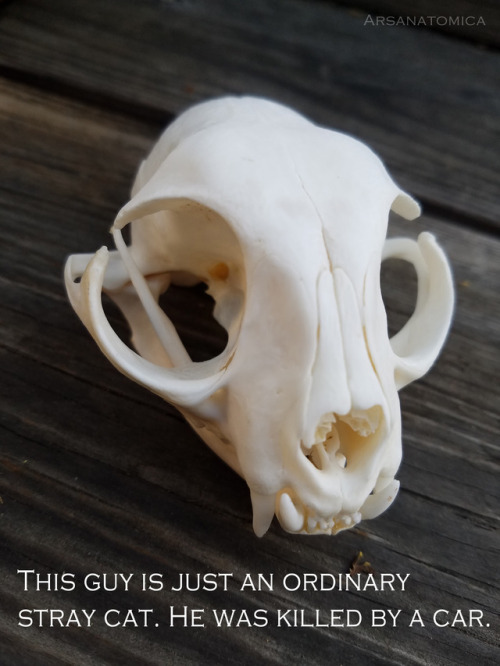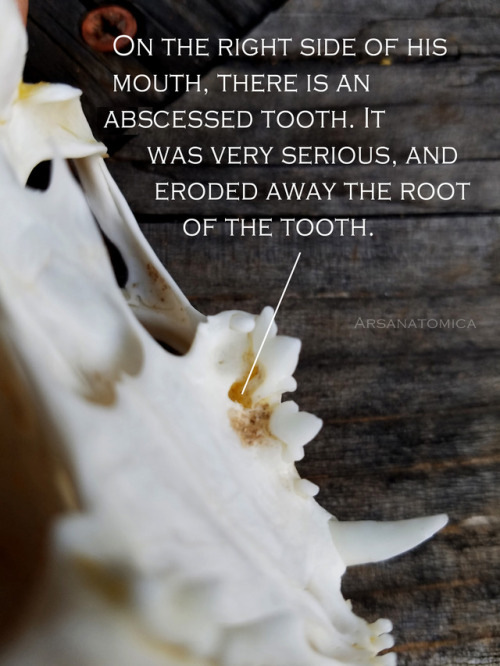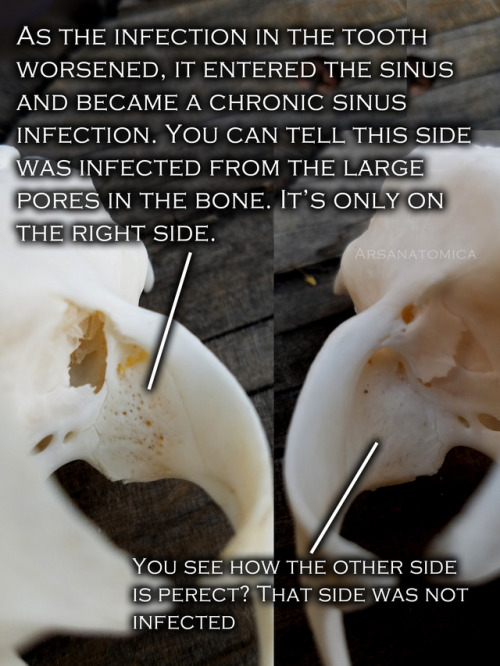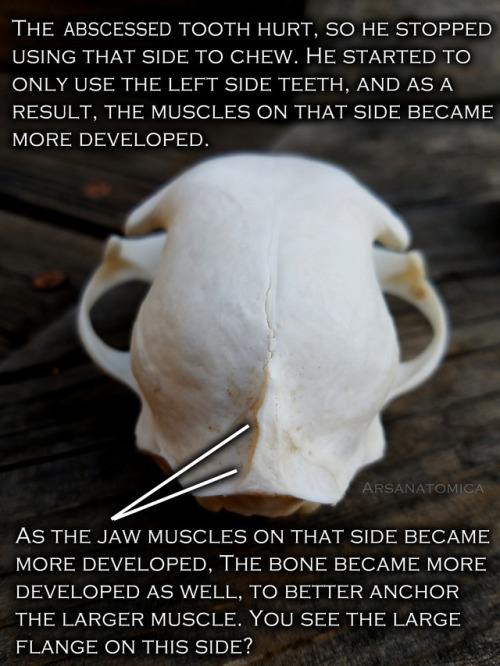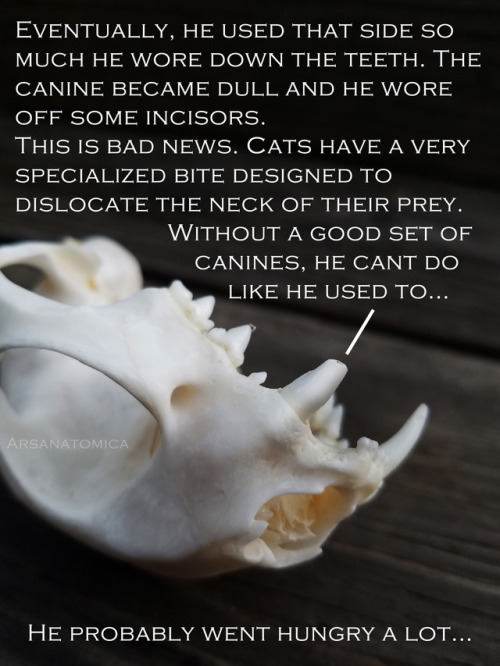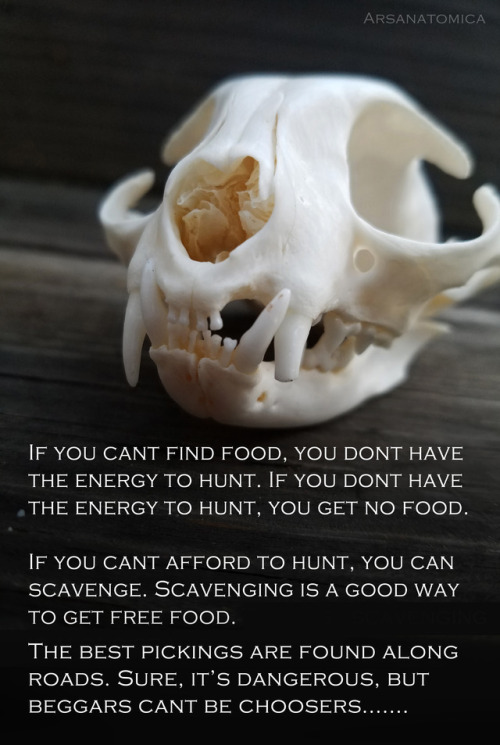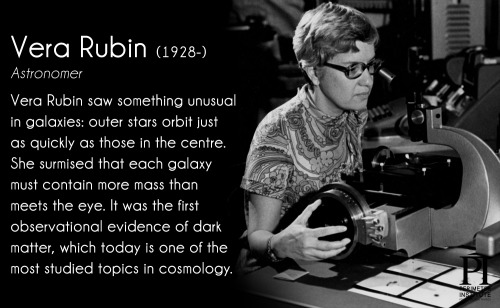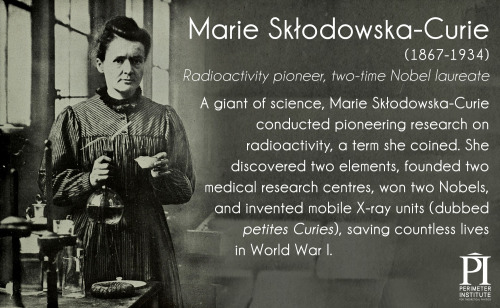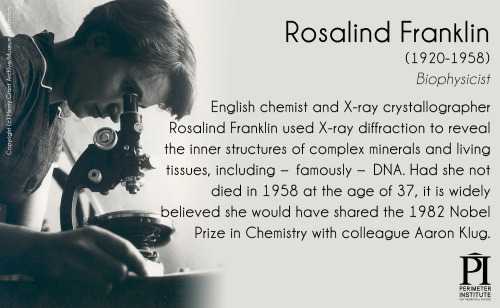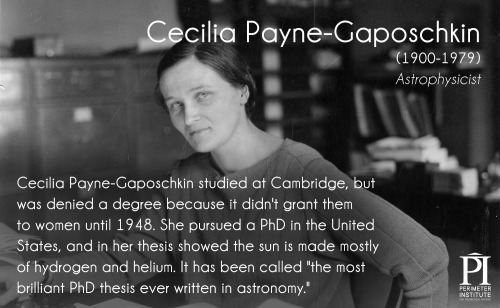t-sci-eng
117 posts
Latest Posts by t-sci-eng



Thought this was important to post.






Okay, I’ve really missed talking about teratology.
These dogs have polydactyl, but what’s interesting is that the extra dew claws can move independently of one another and grip things. They’re only found on the hind feet giving the dogs a distinctly velociraptor look
The Beauceron is an ancient breed, and no one has a definitive answer of why they have these, but the prevailing theory is that they were bred to do a lot of rock climbing because they were used for herding and hunting over rocky mountainous terrain.
Other places to see my posts: INSTAGRAM / FACEBOOK / ETSY / KICKSTARTER

The ocean is where the aliens live.
Transcript under the cut.
Patreon | Instagram | Facebook | Twitter | deviantArt
Keep reading

Crows and ravens are pretty well known for their incredible smarts. In this experiment, psychologists sought to determine how well New Caledonian crows can infer weight.
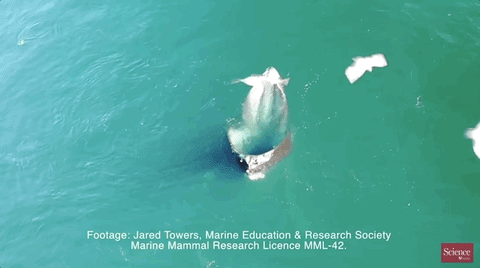
apparently one whale years ago was observed doing this for hours and now more and more whales in the area are seen copying it so we think it’s a whole new behavior and it seems to be a response to shrinking food sources.
Instead of expending any energy actively hunting, the whale just holds its mouth open wherever fish are being hunted by birds. To escape the birds, the fish try to hide in the whale’s mouth because it’s a darker area that looks like shelter. …They’re turning into giant, sea-mammal pitcher plants.
https://onlinelibrary.wiley.com/doi/epdf/10.1111/mms.12557?referrer_access_token=bXLTS5BeSw_vlIKHkM0bYIta6bR2k8jH0KrdpFOxC654HjreJ8D19K86UreR5JPsSRb0CuGhiJSV1L1ht-N1Gf_K_1a9MREFzQGU9oJDNctsKDin_HXcYEdsLg3EbcTl

IMPOSSIBLE! Right? You may have heard “the interior angles of a triangle always add up to 180 degrees”. This is not always true. Check out the second image, it shows a triangle with 3 right angles for a total of 270 degrees!
It is true in flat Euclidean geometry (the geometry you probably learned in school) however. But there are so many other geometries out there! You may be thinking, are other geometries real though? A mathematician would argue they are just as real as the typical flat geometry you know and love (or hate). These alternative geometries can be practically useful too!
The images above show triangles in spherical geometry. Those aren’t triangles though! Oh but they are! A triangle is just a polygon enclosed by three lines. Looks like it fits the criteria. Wait but those aren’t lines, they are curved! Ah yes. I argue that these are, for all intents and purposes, just as good as lines. We need to ask: What is a line? A line is so basic to us we may not know how to describe it. I offer this definition: A line is the shortest path between 2 points. The 3 curves that make the triangle above are in fact the shortest paths from one vertex to the other on the surface of the sphere (they just so happen to be on circumferences of the sphere, which are often referred to as great circles). So it may be more useful to think of lines, in general, as length minimizing curves. In conclusion, we would consider the shape above to be a triangle as it is enclosed by 3 length minimizing curves on a surface.
Spherical geometry can be very useful; think about the Earth. To reduce travel time, airplanes would want to travel along great circles as they are the shortest paths from one place to another. Additionally, this type of thinking (rethinking straight lines as length minimizing curves) is central to Albert Einstein’s general theory of relativity.
read more at http://staffrm.io/@missnorledge/35H6cS1T52

Science Fact Friday: Bird lungs! Just like every other part of a bird, they’re weird.
This gif shows the path of a single breath, but the circuit holds 2 breaths at a time. So when the bird inhales, the just-inhaled breath goes through Inhalation 1 while the previous breath goes through Inhalation 2. Rinse, repeat. Thus, the lungs are constantly receiving oxygen - in mammals, our oxygen content dips slightly between inhalations because there’s no fresh air coming in. We also don’t empty 100% of our lung volume so some air is “stale” even during an inhalation.
Support Science Fact Friday on Patreon!
Transcript below the break.
Keep reading








Are Cloaking Devices Coming? Metalens-Shaped Light May Lead The Way
“The biggest challenge facing a real-life cloak has been the incorporation of a large variety of wavelengths, as the cloak’s material must vary from point-to-point to bend (and then unbend) the light by the proper amount. Based on the materials discovered so far, we haven’t yet managed to penetrate the visible light portion of the spectrum with a cloak. This new advance in metalenses, however, seems to indicate that if you can do it for a single, narrow wavelength, you can apply this nanofin technology to extend the wavelength covered tremendously. This first application to achromatic lenses covered nearly the full visible-light spectrum (from 470 to 670 nm), and fusing this with advances in metamaterials would make visible-light cloaking devices a reality.”
What would it take to have a true cloaking device? You’d need some way to bend the light coming from all across the electromagnetic spectrum around your cloaked object, and have it propagate off in the same direction once it moved past you. To an outside observer, it would simply seem like the cloaked object wasn’t there, and they’d only view the world in front of and behind them. Even with the recent advances that have been made in metamaterials, we have not yet been able to realize this dream in three dimensions, covering the entire electromagnetic spectrum, and from all directions. But a new advance in metalens technology might get you the full electromagnetic spectrum after all, as they appear to have solved the problem of chromatic aberration with a light, small, and inexpensive solution. If we can combine these two technologies, metalenses and metamaterials, we just might realize the dream of a true invisibility cloak.
Whether you’re a Star Trek or Harry Potter fan, the ability to turn yourself invisible would be Earth-shattering. Come see how transformation optics might transform the world!
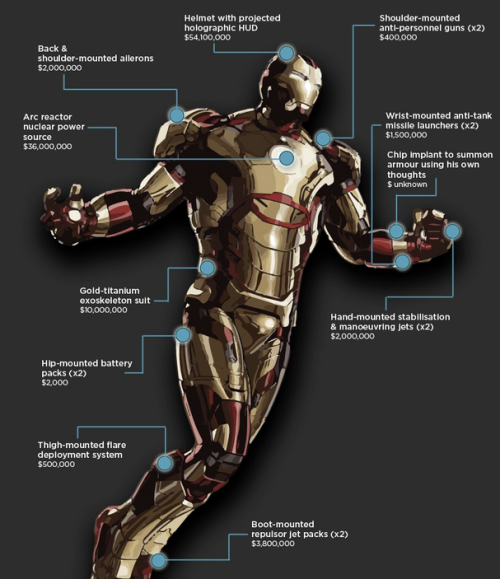
Dissecting Iron Man Suit - An Engineering Analysis
Structural, energy, and thermal analysis of Iron Man Suits specifically Mark I to Mark XLVI which have the following capabilities in common: external armor, supersonic flight, hovering, weaponry, and decoy flares.
1. STRUCTURAL ANALYSIS
Wear Resistant and Shock Absorbent Exoskeleton The physical protective value of exoskeleton is its ability to resist any penetrative loads as well as any shock loads. However, the whole thickness of exoskeleton panels should not be too hard because it will pass on the external impact load into the suit’s internal hardware, or even the human body inside it. All of this can be achieved by combining more than one materials; a hard material on the outside and the soft material on the inside
Hard Outer Layer for Penetrative Loads The materials needed for the exoskeleton’s outer layer should be hard and tactile. Titanium Alloy would be an ideal choice. Fiber glass has good tensile strength but not good shear strength, while titanium has both .Titanium Alloy is not only much stronger, but is also lighter than steel, which will provide more fluidity of movement compared to any heavy material counterparts.
Ductile Inner Layer for Shock Loads There should be a soft inner linings behind titanium panels to serve as shock absorbent. Sorbothane is a material that is extremely soft and has the ability to convert shock loads into heat transfer at a molecular level. It is a proprietary, visco-elastic polymer. Visco-elastic means that a material exhibits properties of both liquids (viscous solutions) and solids (elastic materials).
Sorbothane is a thermoset, polyether-based, polyurethane material. Sorbothane combines shock absorption, good memory, vibration isolation and vibration damping characteristics. In addition, Sorbothane is a very effective acoustic damper and absorber. Even if one drops an egg from the top of a building into a bed of sorbothane, this remarkable material is soft enough to cushion the impact and would not allow the egg to break.
This technique of having a hard material on the outside and the soft material on the inside is not new. It has been used for centuries in Japan for making samurai swords. The hardness of its outer layer give the swords its cutting edge and penetrative power, and its ductility allows it to absorb shock loads when it strikes or struck.
2. ENERGY ANALYSIS : Hovering Capability
Hovering using thrusters (aka repulsors) requires tremendous amount of energy, particularly when the suit is used for a long duration. Energy usage for hovering is dependent upon the hovering methods
Magnetic Levitation requires no energy at all, but is limited to the presence of magnetic field.
Ducted and Open Propellers (helicopter blades). Several human powered helicopters have been made overtime that have achieved flight. It has been experimentally recorded that a 78 kg person in a 58 kg copter requires only 1.1 kW to climb using helicopter blades, and only 60 Watts to maintain altitude.
Jet Thrust is the least energy-efficient method. Because thrust-to-weight ratio needs to be greater than 1 to achieve lift-off, a Jet-pack requires over 1KN of thrust force, depending on the weight of the jet and the person. If wings are attached to the jet-pack, horizontal flight can be achieved with thrust to weight ratio lower than 1, thus improving the duration of the flight and its range.There have been jet-packs made in the past, most iconic display of it was in 1994 Olympics opening ceremony. The fuel used in the jet-pack was mostly hydrogen peroxide. It provides thrust at low temperature compared to other fuels. However, it has low energy density of 810 Wh/kg, giving the jet-packs up to only 30 seconds of flight-time. Jet’s flight time is limited even by using energy-rich fossil fuel. Yves Rossy (aka Jet Man) has successfully used kerosene oil in his flight, but the thruster jets have to be pushed away from the body for safety. His suit allows only several minutes of flight. In addition, if a heavier suit (greater than 25 kg) is used, hydraulics are needed, which would require additional energy and slow down mobility. The Iron Monger suit was an example of hydraulic-driven mobility suit.
3. POWER SOURCE
Tony Stark manages the suit’s energy requirements, including thermal management and artificial intelligence system, through the fictional arc reactor. The reactor is able to provides almost limitless clean energy despite being a very small device. In real life, the only thing that has an energy density comparable to the arc reactor, and would meet all the energy requirements of the suit would be nuclear power. Uranium (fission) energy density is 80.620.000 MJ/kg. However, nuclear power is not suitable to be harnessed in a manned suit, since it generates a tremendous amount of heat.
A more practical solution would be a battery energy-storage. If lithium batteries are used on propeller blades, minutes-long flight time can be achieved. Furthermore, these batteries can readily power suit’s electrical devices / electronics requirements. Lithium ion battery has energy density of 150 Wh/kg (0.5 MJ/kg). Fossil fuel, on the other hand, have a much higher energy density than batteries, but would require a clunky generator to power the suit’s electrical requirements.
Lithium sulfur batteries have 5 times more energy density compared to lithium ion batteries. Lithium sulfur packs had already powered the longest unmanned flight for more than 30 hours. Unless we discover something like an arc-reactor, lithium sulfur batteries could be just the thing to power up the suit. The downside is, it requires hours of charging for just minutes of usage.
There is an alternative option, though not a ‘reactor’ proper. A compact and high-output generator (standard car alternators crank out 50-70 amps at 12 volts for years, and some can go as high as 150 amps) could be spun by a small and strong output electric motor (all alternators have to do is spin). That motor can be powered by a high density battery like used for electric bikes in the 1500w to 2500w range at 20 something volts. This would power a strong and small motor at 3500 to 4000 rpm for hours. That’s more than enough to create power for a number of systems, if they’re built to take advantage of the amperage. And with new constructions of carbon arrays coming out every day, one or more of those could bring a meaningful electric output increase in an otherwise standard generator, even above what we have in cars now.
4. THERMAL MANAGEMENT
The suit cannot be hermetically sealed. Human body heat evaporates water from the skin. Therefore, air ventilation is a must to remove them. It is also needed to maintain a good supply of oxygen. So, there must be a structure inside the exoskeleton that allows air flow. This would prevent any internal condensation to settle and will also remove buildup of body heat. The layer of sorbothene would act both as a thermal and an electrical insulator. This means that extreme external temperature would not be transferred to the inner layer. The suit would not get too hot or too cold from the outer environment. There should be small fans to draw and pull air from the ambient in controlled amount, and should be able to exchange hot air. With the technology available today, the thermal management of the suit is easily manageable. There are also solid state devices such as thermal pads and thermoelectric generators. Thermoelectric generators can surfaces hot or cold depending on the polarity of the electric current and thus can be an integral component of the suit for controlling the internal temperature.
Source (x)
Keep reading
What is Liquid Penetrant Testing?
Liquid penetrant testing (LT) is a non-destructive testing technique utilized to detect defects or discontinuities (such as cracks) on the surface of any type of non-porous material such as metal, plastics or ceramics. Liquid penetrant testing (also known as dye penetrant testing or penetrant testing) is primarily utilized in the industrial sector to test metal materials such as oil & gas pipelines and various metal machinery components to prevent failures or accidents. Some of the many defects that can be detected using this process include fatigue cracks, hairline cracks and porosity. A number of industries utilize liquid penetrant testing, including petrochemical, aerospace, engineering, automotive and many more.
Although liquid penetrant testing is the least technologically advanced method of non-destructive testing (with the others being ultrasonic testing, magnetic particle testing and radiography) – it is still widely used. That’s because liquid penetrant testing has the advantages of being low in cost, versatile and easy to perform. In fact, liquid penetrant testing requires very little training when compared to the other three main forms of non-destructive testing.
So exactly how does liquid penetrant testing work? The material to be tested must first be cleaned – usually using a simple spray cleaner that can be easily wiped off with a cloth or rag. A liquid penetrant solution is then applied to the surface of the material being tested using a simple aerosol spray from a can. The liquid is then left to soak for a predetermined length of time – and will eventually seep into or be drawn into any cracks or defects within the material being tested. After the appropriate amount of “soak time” has passed, the technician wipes the liquid penetrant off of the test object. A developer is then applied to the entire area being tested. The developer is usually a dry white powder such as chalk that is suspended in liquid and sprayed on in aerosol form. The developer then acts to draw out any liquid that may have seeped into a defect – giving a highly visible, colored indication on the surface of the test object.
Liquid penetrant testing relies solely on visual inspection – making the color contrast between the object being tested and the colored indication that reveals defects of utmost importance. For this reason, many technicians utilize fluorescents. This process is the same as conventional liquid penetrant testing, with the exception that a fluorescent penetrant is utilized and then the test object is viewed under ultraviolet light in a darkened environment. The result is that any defects present will glow brightly under the UV light – making visual inspection much easier.
Aside from the obvious advantages of being inexpensive and easy to use, liquid penetrant testing is also popular because of its versatility. In most cases, nothing more than three aerosol cans – cleaner, penetrant and developer – and a few cloths or rags are needed. This allows technicians to easily maneuver into tight spaces such as boilers or high places where ladders are required – easily completing testing in locations where other non-destructive testing techniques are difficult or impossible. For these reasons, liquid penetrant testing continues to be a viable and popular non-destructive testing method.
Tech Service Products is a stocking distributor of industrial supplies and non-destructive testing products such as liquid penetrant testing products.
How platinum powers the world

Platinum bars. Image: Sprott Money@Flickr
Platinum is one of the most valuable metals in the world. Precious and pretty, it’s probably best known for jewelry – and that is almost certainly its oldest use. But its value has become far greater than its decorative ability; today, platinum powers the world. From agriculture to the oil markets, energy to healthcare, we use platinum far more than we realise.
1. Keep the car running

Platinum is needed to make fuel for transport. Image: Pixabay
Platinum catalysts are crucial in the process that converts naphtha into petrol, diesel, and jet-engine fuel, which are all vital to the global economy. The emissions from those petroleum fuels, however, can be toxic, and platinum is also crucial in the worldwide push to reduce them through automotive catalytic converters. In fact, 2% of global platinum use in 2016 was in converting petroleum and 41% went into reducing emissions – a circle of platinum use that’s more impressive than a ring.
2. Feed the world

Nitric acid is a by-product of platinum which is used in fertilisers. Image: Pixabay
Another vital global sector that makes use of platinum catalysts is agriculture. Without synthetic fertilisers, we would not be able to produce nearly as much food as we need. Nitric acid is essential for producing those fertilisers and platinum is essential for producing nitric acid. Since 90% of the gauzes required for nitric acid are platinum, we may need to use more of it as we try to meet the global food challenge.
3. Good for your health

A pacemaker. Image: Steven Fruitsmaak@Wikimedia Commons
Platinum is extremely hard wearing, non-corrosive, and highly biocompatible, making it an excellent material to protect medical implants from acid corrosion in the human body. It is commonly used in pacemakers and stents. It is also used in chemotherapy, where platinum-based chemotherapeutic agents are used to treat up to 50% of cancer patients.
Keep reading
NTU and JTC develop enhanced fire protection for steel

Credit: shutterstock/Anusorn Abthaisong
Scientists from Nanyang Technological University (NTU), Singapore, and national industrial developer JTC have unveiled what they are calling a 3-in-1 coating for better fire and corrosion protection.
‘In a fire, our coating forms a compact charred layer that acts as a protective barrier against the heat,’ explained Aravind Dasari, a Principal Investigator at the NTU–JTC Industrial Infrastructure Innovation Centre.
Called FiroShield, the coating functions like regular paint and is easy to apply, according to the research team. It can be applied on bare steel without the need for sand blasting, and provides protection against fire for two hours.
Dasari explained, ‘While typical fire coatings will also form a charred layer, those are thick and foam-like, which can fall off easily and leave the steel exposed to the fire. What we aimed at was an innovative coat that works differently from conventional intumescent coatings and can stick to the steel surface for as long as possible under high temperatures, and yet has durability and weather resistance under normal conditions without a need for a top coat of paint.’
To find out more see the January issue of Materials World or visit bit.ly/2nft8Z3
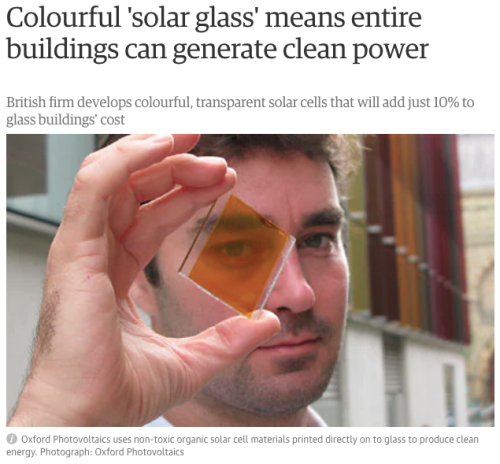


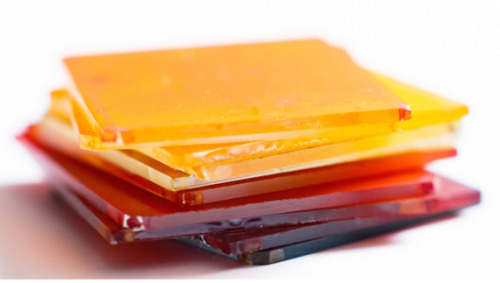
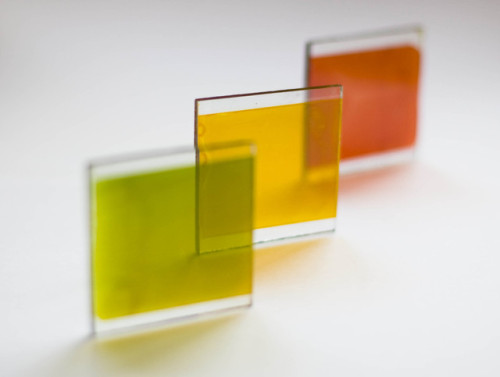
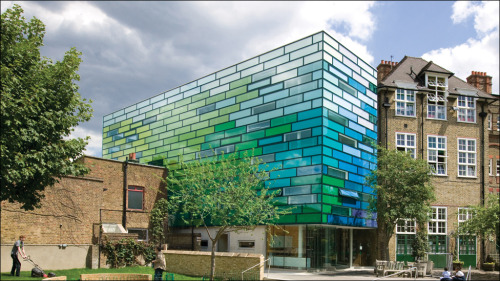
Just imagine a world full of beautiful stained glass windows which also generate electricity…
[Oxford Photovoltaics]










Overwhelming Cloaking Devices And False Peace Highlights Star Trek: Discovery, Season 1 Episode 8
“Can you please make it stop, even for a moment? We were biologically determined for one purpose and one purpose alone: to sense the coming of death. I sense it coming now. We have come to Pahvo for your help. We have come to end this war. I am so afraid. So. Afraid.”
You’re in a time of war, and your enemy has a technological advantage that makes you unable to fight them on equal footing. This has happened so often throughout history: with iron vs. bronze weapons; with the invention and application of gunpowder; with the rise of nuclear capabilities. In space, the augmentation of a cloaking device makes the Klingons virtually invincible, and the Federation is losing this war, badly. What are they to do? What comes next? The ability to see an invisible ship is what’s needed, and this latest episode highlights an attempt to do so, by exploiting an uncontacted alien world. The aliens there are sentient, however, so using this technology would be a violation of both the Prime Directive and First Contact protocols. But what’s the ethical thing to do? Is it better to not interfere and face certain defeat? Or to exploit their technology, violate your principles, and gain the advantage?
Star Trek: Discovery is a show where right-and-wrong isn’t so cut-and-dry. Despite its flaws, it’s an interesting development that makes you think, without providing easy answers. Those, fortunately, will come next episode!

Students fortify concrete by adding recycled plastic
Adding bits of irradiated plastic water bottles could cut cement industry’s carbon emissions
Discarded plastic bottles could one day be used to build stronger, more flexible concrete structures, from sidewalks and street barriers, to buildings and bridges, according to a new study.
MIT undergraduate students have found that, by exposing plastic flakes to small, harmless doses of gamma radiation, then pulverizing the flakes into a fine powder, they can mix the plastic with cement paste to produce concrete that is up to 20 percent stronger than conventional concrete.
Concrete is, after water, the second most widely used material on the planet. The manufacturing of concrete generates about 4.5 percent of the world’s human-induced carbon dioxide emissions. Replacing even a small portion of concrete with irradiated plastic could thus help reduce the cement industry’s global carbon footprint.
Reusing plastics as concrete additives could also redirect old water and soda bottles, the bulk of which would otherwise end up in a landfill.
Read more.

This month on FYP!
It has been a blissful month in physics with the nobel prize for the work on gravitational waves and LIGO swiftly striking back with the detection of a neutron star merger.
At FYP! we have started to dwell a little bit into the essence of condensed matter physics while exploring some really cool science and engineering along the way.
Here’s what went down on FYP! this month:

Nobel prize in physics article on Gravitational waves
Gravitational waves, Light and Merging neutron stars

Paramagnets and Combinatorics
Diamagnetic levitation - Ig Nobel prize(2000)
Levitating frogs and superconductivity

Revisiting rolling shutter
Cooking with a computer (the importance of a heat sink on a computer)
Cartoon laws of physics
Beautiful proofs (#3) - Euler’s sum
Have a great day!
These giant mesh nets provide drinking water in the driest desert on Earth.
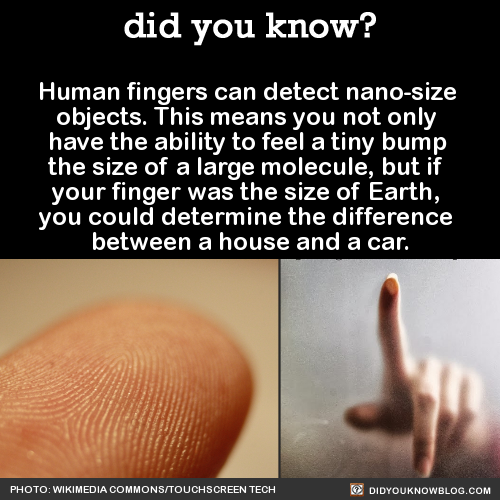
Human fingers can detect nano-size objects. This means you not only have the ability to feel a tiny bump the size of a large molecule, but if your finger was the size of Earth, you could determine the difference between a house and a car. Source





Google’s Wireless ‘Pixel Buds’ Headphones Can Translate 40 Languages in Real Time
It’s a good Sunday. 🤗
To get the Sunday week summary delivered to your inbox subscribe here.
Experimental Saturday
Meet the ‘400k pie’

Banana whey protein bread

Interesting and fun stuff
Work vs Hobbies [Comic]
Use a Pencil to Freeze Sauce into Usable Portions
Bake the Perfect Pound Cake
Best Chocolate Chip Cookie Bake Off
Recipe lists
10 PUMPKIN SPICE FAVORITES
Ten Minute Meal Prep Recipes and Prep Ideas
10 DESSERTS AND COOKIES TO TRY FOR FALL
20 PUMPKIN RECIPES FOR FALL
25 APPLE RECIPES TO GET YOU READY FOR FALL
19 OF THE BEST EASY & HEALTHY ONE PAN MEALS
Our Favorite Pumpkin Recipes
Food days
Cheeseburger 🍔
Butterscotch Pudding
Rum Punch 🍹
Pecan Cookies
White Chocolate
Top recipes!
Classic Snickerdoodles

Fresh & Flavorful Strawberry Cake Recipe

Double Chocolate Brownies

RED VELVET SUGAR COOKIES RECIPE

BROWN SUGAR POUND CAKE

Ginger Fig Tart with Chestnut-Almond Crust {vegan & gluten-free}

RED VELVET MACARONS WITH CREAM CHEESE FROSTING

My Mom’s Homemade Spaghetti and Meat Sauce

APPLE FRITTER PANCAKES

Bacon Tomato and Spinach Spaghetti

PUMPKIN PIE SPICE PROTEIN SMOOTHIES

Apple Spice Ricotta Donuts

pumpkin gnocchi with sage butter sauce

Mashed Potato Fries

QUICK POTATO ROLLS

Follow for recipes
Get your FoodFfs stuff here
What can we learn from ants and plants?
That’s what IBMer Mauro Martino set out to answer in his award-winning data visualization, Network Earth. It explores nature’s interconnected relationships, and how they affect each other and our planet. By making the complex but important topics easier to visualize, we hope to help make more of them accessible to all.


It’s easy: Form a triangle, then a hexagon, then a bicycle wheel
This is the general mechanism on how a spider spins its web (talk about engineering, right?). When an insect gets caught in its web, the vibrations caused by the insect is felt by the spider which then rushes to engulf its prey.
Now here is the trippy part ; This is the effect of drugs on the pattern of the web.


Hope you are having a great week. Have a good one!
* Spider spinning a web (video) (if you find a better full video let us know)
** Spiders on drugs - NASA article ; Video

What have eclipses ever done for science? Quite a lot, actually!
The first measurement of the width of the Atlantic ocean in the 16th Century



When British settlers arrived in Virginia in the US, they weren’t sure how far across the globe they’d gone. They recorded the local time of a total eclipse of the moon - which is seen all across the night-time side of the planet. Their colleagues in London did the same, and when the travellers returned they could figure out the five hour time difference.
Edmond Halley discovered that the moon is moving away from the Earth


Halley realised you could back-calculate when previous eclipses would have occurred. But he noticed a mismatch between his predictions and the history books. The reason, he discovered, what that he was assuming the moon stayed the same distance from the Earth. It is actually getting further at about the rate your fingernails grow. And that means that one day (in a few million years, that is), the moon will be too far away to create any more total solar eclipses.
In 1919 a solar eclipse proved Einstein’s theory of relativity

Einstein’s theory predicted that the sun’s gravity should bend the light of nearby stars, meaning that in theory we should be able to see stars that are hidden just behind the sun. However, sunlight always blocks our view of these stars, and it was only during a solar eclipse that there was a short window to see if hidden stars were visible, as predicted. Astronomer Arthur Eddington travelled to West Africa and took photos that proved Einstein right.
Scientists still use solar eclipses today
It’s very hard to study the sun’s corona - a tenuous hot gas, which just one millionth of the light intensity of the sun. The shapes and lines of the corona show the nature of the sun’s magnetic field, and are only visible to study during an eclipse. NASA are also using this opportunity to help create the first thermal map of Mercury!
Want to know more? Watch our full video.

What have eclipses ever done for science? Quite a lot, actually!
The first measurement of the width of the Atlantic ocean in the 16th Century



When British settlers arrived in Virginia in the US, they weren’t sure how far across the globe they’d gone. They recorded the local time of a total eclipse of the moon - which is seen all across the night-time side of the planet. Their colleagues in London did the same, and when the travellers returned they could figure out the five hour time difference.
Edmond Halley discovered that the moon is moving away from the Earth


Halley realised you could back-calculate when previous eclipses would have occurred. But he noticed a mismatch between his predictions and the history books. The reason, he discovered, what that he was assuming the moon stayed the same distance from the Earth. It is actually getting further at about the rate your fingernails grow. And that means that one day (in a few million years, that is), the moon will be too far away to create any more total solar eclipses.
In 1919 a solar eclipse proved Einstein’s theory of relativity

Einstein’s theory predicted that the sun’s gravity should bend the light of nearby stars, meaning that in theory we should be able to see stars that are hidden just behind the sun. However, sunlight always blocks our view of these stars, and it was only during a solar eclipse that there was a short window to see if hidden stars were visible, as predicted. Astronomer Arthur Eddington travelled to West Africa and took photos that proved Einstein right.
Scientists still use solar eclipses today
It’s very hard to study the sun’s corona - a tenuous hot gas, which just one millionth of the light intensity of the sun. The shapes and lines of the corona show the nature of the sun’s magnetic field, and are only visible to study during an eclipse. NASA are also using this opportunity to help create the first thermal map of Mercury!
Want to know more? Watch our full video.

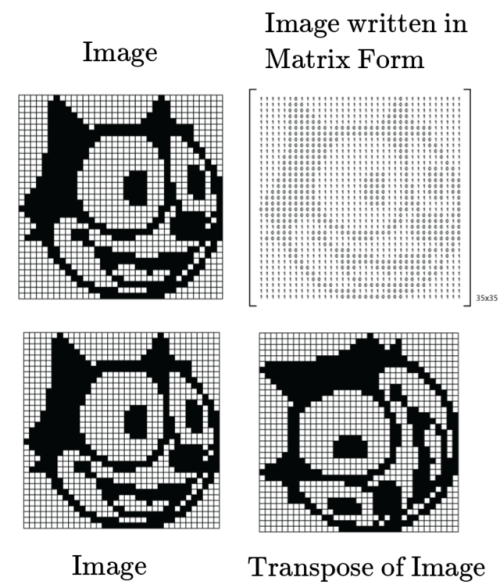

On the transpose of a matrix
In this post, I would just like to highlight the fact an image can be represented in a matrix form and matrix transformations such as transpose, shearing, scaling, etc, from an image processing point of view are purely physical !
Check out this article from the klein project if this post interested you.
Have a great day!
* Interactive Felix the cat and matrix

